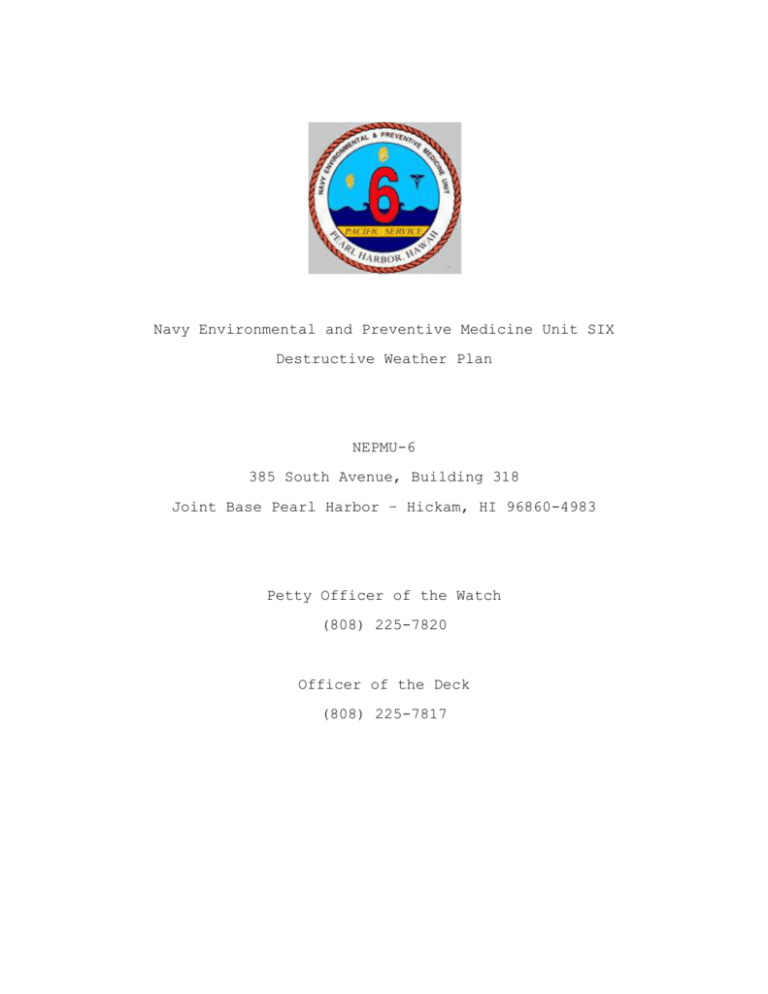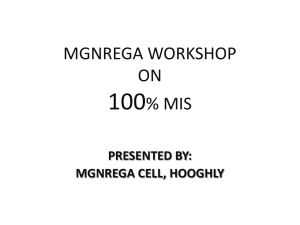Destructive Weather Plan and Checklist
advertisement

Navy Environmental and Preventive Medicine Unit SIX Destructive Weather Plan NEPMU-6 385 South Avenue, Building 318 Joint Base Pearl Harbor – Hickam, HI 96860-4983 Petty Officer of the Watch (808) 225-7820 Officer of the Deck (808) 225-7817 Destructive Weather Plan and Checklist The purpose of the Destructive Weather Plan and checklist is to prepare the building and grounds of NEPMU-6 for severe weather and potential evacuation. Table 1 provides a checklist of the actions which will be accomplished by Command personnel in preparation for destructive weather. Detailed information on the background and definitions of destructive weather, the Tropical Cyclone Conditions of Readiness (TCCOR) and the JBPHH Destructive Weather protocol can be found in Section IV, Hazard Specific Appendix 1 of JBPHHINST 3440.17A Installation Emergency Management Program. The Destructive Weather checklist will be exercised by NEPMU-6 annually to ensure currency. Copies of the NEPMU-6’s EAP with TCCOR checklists will also be submitted to the JBPHH Office of Emergency Management annually by 01 MAY (prior to the beginning of hurricane season) to maintain situational awareness. The checklists are considered living documents which may be changed at any time without requiring prior approval by the original signature authority. Appendix A provides a list of supplies which will be maintained in the hurricane locker for use in destructive weather preparation. During an actual emergency, attainment of each TCCOR level will be reported to the Emergency Operations Center (EOC) at: (808) 448-2570/2583/3263 or the JBPHH CDO at: (808) 864-2460; email: prlh_cdoNSP@navy.mil. TCCOR level attainment can also be reported in-person directly to the C4I operations center. Table 1. Destructive Weather/Conditions of Readiness Checklists Destructive Weather Checklist TCCOR 5 1 Jun – 30 Nov Item # 1. Action/Task OPR ; Identify and All 2. mitigate flying debris/missile hazards Hands Ensure the availability of emergency equipment: flashlights, plastic sheeting, plastic bags, duct tape RO 3. Ensure all personnel have ‘hurricane kits’ at home All Hands 4. Ensure all personnel have a shelter plan and know location of their muster facility RO 5. validate plans and TCCOR checklists associated with destructive weather annually by 1MAY RO 6. Submit EAP and TCCOR checklists to JBPHH Office of Emergency Management annually by 1MAY RO 7. and conduct hurricane awareness command RO briefs. 8. that will RO remain on station during landfall 9. hurricane RO evacuation exercise. Destructive Weather Checklist TCCOR 4 72 hrs to landfall TCCOR 4 may be implemented several times a year as hurricanes or tropical depressions approach and then either dissipate or change direction. These items should therefore not incur non-budgeted cost. 1. y Command personnel, move to TCCOR 4 RO 2. All Hands debris/missile hazards 3. 4. 5. Admin and generators are fueled to capacity and properly secured ort attainment of TCCOR 4 to EOC CDO RO Destructive Weather Checklist TCCOR 3 48 hrs to landfall TCCOR 3 items can be anticipated to incur unfunded costs. Joint Base activities may not see any reimbursement, especially if destructive weather does not materialize. 1. ommand personnel, move to TCCOR 3 If outside of normal working hours, conduct phone muster vs. recall if personnel required on station 2. -planned RO and CDO Admin support for preparedness and recovery 3. debris/missile hazards All Hands DO NOT TAPE THE WINDOWS OR GLASS DOORS. They are made of safety glass and taping weakens the laminate after the tape is removed. 4 Admin 5. Admin force for recovery and to ensure personnel can protect their homes 6. Admin RO 7. and initiate action as necessary to be able to attain readiness in 24 hours 8. ort attainment of TCCOR 3 to EOC RO Destructive Weather Checklist TCCOR 2 24 hrs to landfall TCCOR 2 items can be anticipated to incur non-budgeted costs. If TCCOR 2 is set, there is a very high probability that Joint Base activities will be impacted by severe weather and the damage anticipated by the upcoming storm far outweighs the costs associated with the shutting down of operations and preparing for the storm. 1. to TCCOR 2 of impending RO and CDO storm 2. 3. RO Cease routine activity as necessary to exert maximum effort toward securing for a storm. On attainment of TCCOR 2, Command should be able to completely secure for a storm within 12 hours. Ensure all windows and doors are secured Secure all loose gear and portable equipment All Hands Bring Gator into warehouse -up computer hard drives and store disks in sealed plastic bags water intrusion and flooding Place all computers in plastic bags Ensure all copiers, office equipment and other valuable items (books, files etc.) are covered in plastic and moved off the deck to at least desk top level if possible. Waterproof the doors and dials of the safe by either covering door frame and dial with masking tape or enclosing the safe in polyethylene plastic and sealing the edges Secure non-essential telephones by disconnecting and placing in water-tight plastic bag Telephone use is for official business only to avoid overwhelming the phone lines to capacity and properly secured 4. Admin of the area to be impacted by the hurricane 5. 6. -essential personnel from installation upon completion of TCCOR 2 check lists ort attainment of TCCOR 2 to EOC Destructive Weather Checklist TCCOR 1 Admin RO 12 hrs to landfall TCCOR 1 items can be anticipated to incur non-budgeted costs. These items should be ones that finalize the preparations for destructive weather. 1. 2 ommand personnel, move to TOCCOR 1 Finalize facility preparations RO BM Ensure fuel level in Command vehicles are topped off Turn off air conditioning system Disconnect the power supply to all non-critical equipment, including electrical appliances The main breaker box must be shut off if any water enters the building during or after the storm 3. 4 5. of non-essential personnel Complete final preparations/actions by departments to ensure continuity of business functions will be minimally affected by storm damage ort attainment of TCCOR 1 to EOC CDO Dept Heads RO Destructive Weather Checklist TCCOR 1E TCCOR 1E items are concerned with sheltering in place and JBPHH Emergency Operations. No personnel are authorized to be outside during TCCOR-1E. 1. -in-place or evacuate to a Hurricane Shelter and remain there until all clear is sounded All Hands engage in rescue/recovery operations during passage of eye of hurricane Destructive Weather Checklist TCCOR R TCCOR R items cover short term rescue and recovery operations. 1. weeks after passage of a severe storm. 2. Conduct phone recall and identify the needs of Command personnel and their families. OOD or Dept Head If phone lines are down, all personnel should muster at NEPMU-6, as soon as possible after the ‘All Clear’ is given, but only if it is safe to do so. If phone lines are down and muster at Unit is incomplete, the OOD or Department Head will attempt to locate personnel and families at appropriate Hurricane Shelter (Tab D). 3. Survey facility for damage. BM 4. must be prepared to assist with rescue and recovery of personnel, restoration of critical and mission essential functions, restoration of normal operations. All Hands Duty personnel will remain on-board to assist JBPHH with the distribution of emergency food and water. Communication during Destructive Weather In the event that destructive weather necessitates that personnel shelter-in-place in their homes, a phone muster will be initiated by the OOD at the earliest opportunity. Contact will be made with all personnel to verify their safety and wellbeing. If such an event forces personnel to evacuate their homes, the evacuated member and family should proceed to the hurricane evacuation center nearest their home. Evacuated personnel will remain at this facility until the “All Clear” is given by CNRH or JBPHH authorities. Once the “All Clear” is given, a phone muster will be initiated by the OOD to account for all personnel. If telephone and other electronic forms of communication are not operational in the aftermath of the storm, all Command personnel should proceed to the Unit for muster – but only if is safe to do so. In the absence of telephone or electronic communications capabilities, if it is not possible for a member to safely transit to NEPMU-6 after the “All Clear” is given, the member should proceed to the hurricane evacuation center listed above their name on the NEPMU-6 Disaster Muster Point Sheet (Appendix B). A representative from the Unit will attempt to locate any individuals not accounted for by other means at the appropriate Muster Points during the time periods specified below in Appendix B. If an individual has been in contact with their department head or other Chain of Command member through any other means, the individual does NOT need to muster at the Muster Point. It is imperative, however, that all personnel be accounted for. Other Types of Destructive Weather In addition to tropical cyclones, hurricanes and other wind related phenomenon, destructive weather can entail a variety of other atmospheric conditions or the resulting anomalies they cause on the earth’s surface. These include high surf, flooding, and thunderstorms. Detailed information related to these hazards and the measures that will be taken by JBPHH to minimize their impact on the base can also be found in the Destructive Weather Appendix of ref (c). The mitigation efforts required to minimize damage to the NEPMU6 facility and equipment from flooding, whether due to high surf or extensive rain, are the same as those required to minimize water damage from a hurricane. The protective steps are contained in TOCCOR checklists 2 and 1 above. These checklists will therefore be followed if a flood warning which has the potential to impact the facility is given for any reason. The mitigation efforts required to minimize damage to the NEPMU6 facility and equipment from a thunderstorm are also specified in the TCCOR checklists. Because of the associated high winds, exterior facility/grounds housekeeping and the elimination of flying debris hazards are especially important. Additionally, if a local thunderstorm warning is announced or Thunderstorm Condition I is set by JBPHH, command personnel will cease all non-essential outdoor work and activity. Appendix A: Emergency Locker Inventory Equipment Flashlight with extra batteries First Aid Kit Weather radio with extra batteries Large plastic trash bags Plastic sheeting Duct tape Plastic bags, gallon size Quantity 2 1 1 2 1 2 5 boxes roll rolls boxes Appendix B: Disaster Muster Point Sheet and SOP for Emergency NEPMU 6 DISASTER MUSTER POINT SHEET PHYSICAL MUSTER POINT: November 2010 Moanalua High School: 2825 Ala Ilima Street, Honolulu, HI96818 LOCATION DURING DISASTER: # OF DEPENDENTS: LOCATION OF DEPENDENTS: DEPENDENT CONTACT NUMBER(S): 3267 Maloelap St., Honolulu 3 Hawaii (619) 757-9260 / (619) 757-9261 LT Sutherland 4956 Tomahawk St., Honolulu 3 Hawaii (808) 744-9365 LT Hendrix-Holmes 1309A Ala Alii, Honolulu NA NA NA HMC Wells Arizona Hall Bldg 1623 Rm: 1405 2/1 CT / FL (860) 392-9623 / (813) 684-3478 HMC Whatley 2792 Gordon St., Honolulu 1 Hawaii (808) 386-2415 HM1 Banag 4615 Scott Lp., Honolulu 2 Hawaii (904) 614-8024 HM1 Brennan 611 Thatcher Ct., Honolulu 3 Hawaii HM1 Desouza* Kapolei HS 4 Hawaii (808) 282-4401 HM1 Rios 1309 Arizona Hall 1 California (619) 956-6529 HM2 Ferguson 1309 Arizona Hall 2 Texas (254) 396-4718 HM2 Conklin 5572 Bennion Dr., Honolulu 1 Hawaii (808) 454-7521 0 NA NA CDR Monteville** Arizona Hall LCDR Juarez* HM2 Curfman HM3 Rojas PHYSICAL MUSTER POINT: Waipahu High School: 94-1211 Farrington Hwy, Waipahu, HI 96797 LOCATION DURING DISASTER: # OF DEPENDENTS: LOCATION OF DEPENDENTS: DEPENDENT CONTACT NUMBER(S): LCDR Oras** 94-560 Lumiauau St. #K-204, Waipahu 3 1 FL, 2 Hawaii (407) 756-8691 / (360) 720-9540 LTJG Birch* 1402 Laniwai Ave, Pearl City 4 Hawaii (713) 715-9877 1 Texas (619) 808-4293 HM1 Torresalvarado 1170 Milionu St. #400, Ewa Beach HM2 Ison Eugene Martos PHYSICAL MUSTER POINT: Aiea High School: 98-1276 Ulune Street, Aiea, HI 96701 LOCATION DURING DISASTER: # OF DEPENDENTS: LOCATION OF DEPENDENTS: DEPENDENT CONTACT NUMBER(S): CDR Torres** 706 McGrew Loop, Aiea 4 Hawaii (407) 319-4438 / (407) 319-4508 LCDR Winningham* 1104 Honu Lp., Aiea or Aiea HS 1 Hawaii LT Crabtree 1104 Honu Lp., Aiea or Aiea HS 0 NA NA LT Meyer 1104 Honu Lp., Aiea or Aiea HS 0 NA NA LT Claeys-Jacobson 1104 Honu Lp., Aiea or Aiea HS 0 NA NA HM2 Sibal 0 NA NA 1104 Honu Lp., Aiea or Aiea HS HM2 Sternberg Ariel Evangelista PHYSICAL MUSTER POINT: Kailua High School: 451 Ulumanu Drive, Kailua, HI 96734 LOCATION DURING DISASTER: # OF DEPENDENTS: LOCATION OF DEPENDENTS: DEPENDENT CONTACT NUMBER(S): LCDR Schutt** 246A Maluniu Avenue, Kailua 3 Hawaii (808) 542-1676 LT Heintschel* 2009 Makiki St., Honolulu 1 Hawaii Deployed Members - Contact Dependents LT Palm 2 HM2 Messina 0 NA NA HM2 Ison 0 NA NA ** Muster Point Leader * Alternate Muster Point Leader Deployed - contact dependents SOP FOR EMERGENCY RECALL: During a hurricane or other natural disaster, personnel will shelter in place at the location designated in the Disaster Muster Point Sheet. If any personnel decide to change locations prior to shelter in place being called, they must contact the designated muster point leader as soon as possible prior to the disaster to inform him/her of the new location. All personnel are to remain at shelter in place until “All clear” is called by JBPHH or CNRH authorities. Depending on the circumstances of the disaster, this “All Clear” notification may be in the form of a phone call, email, website update (Facebook: JBPHH-FCPOA), or radio/television announcement. Once the “All Clear” is given by CNRH or JBPHH authorities, a standard telephone recall/muster will be initiated to account for all personnel and family members. Department Heads will contact the OOD with muster results and the OOD will then contact the OIC. If a member has not been contacted by departmental personnel within 1 hour of the “All Clear’ being given, the member should attempt to initiate contact with someone in their respective department or the POOW/OOD to report their status. Text messaging may be attempted only if regular phone calls fail to go through. In the event that phone lines are incapacitated or contact cannot be made via phone for other reasons, personnel who have not been in contact with NEPMU-6 staff to report status should muster at NEPMU-6 during the hours below or as soon as it is safe to do so. If an individual has no means of transportation to NEPMU 6, and the individual has not been able to reach the Chain of Command through others means, the individual is required to physically muster at the location under which they are listed on the Disaster Muster Point Sheet during the time periods specified below, but only if it is safe to do so. The muster point leader, department head, or other NEPMU-6 representative will attempt to locate any individuals not accounted for by other means at the appropriate Muster Points during these time periods. If an individual has been in contact with their department head or other Chain of Command member through any other means, the individual does NOT need to muster at the Muster Point. Department Heads are responsible for ensuring that civilian personnel and the families of TAD and deployed personnel are contacted. Designated Muster Point Times: 1) If the disaster subsides between the hours of 2400 and 1159, muster at your designated location between 1530 - 1730 the same day. 2) If the disaster subsides between the hours of 1200 and 2359, muster at your designated location between 1000 - 1200 the following morning.






